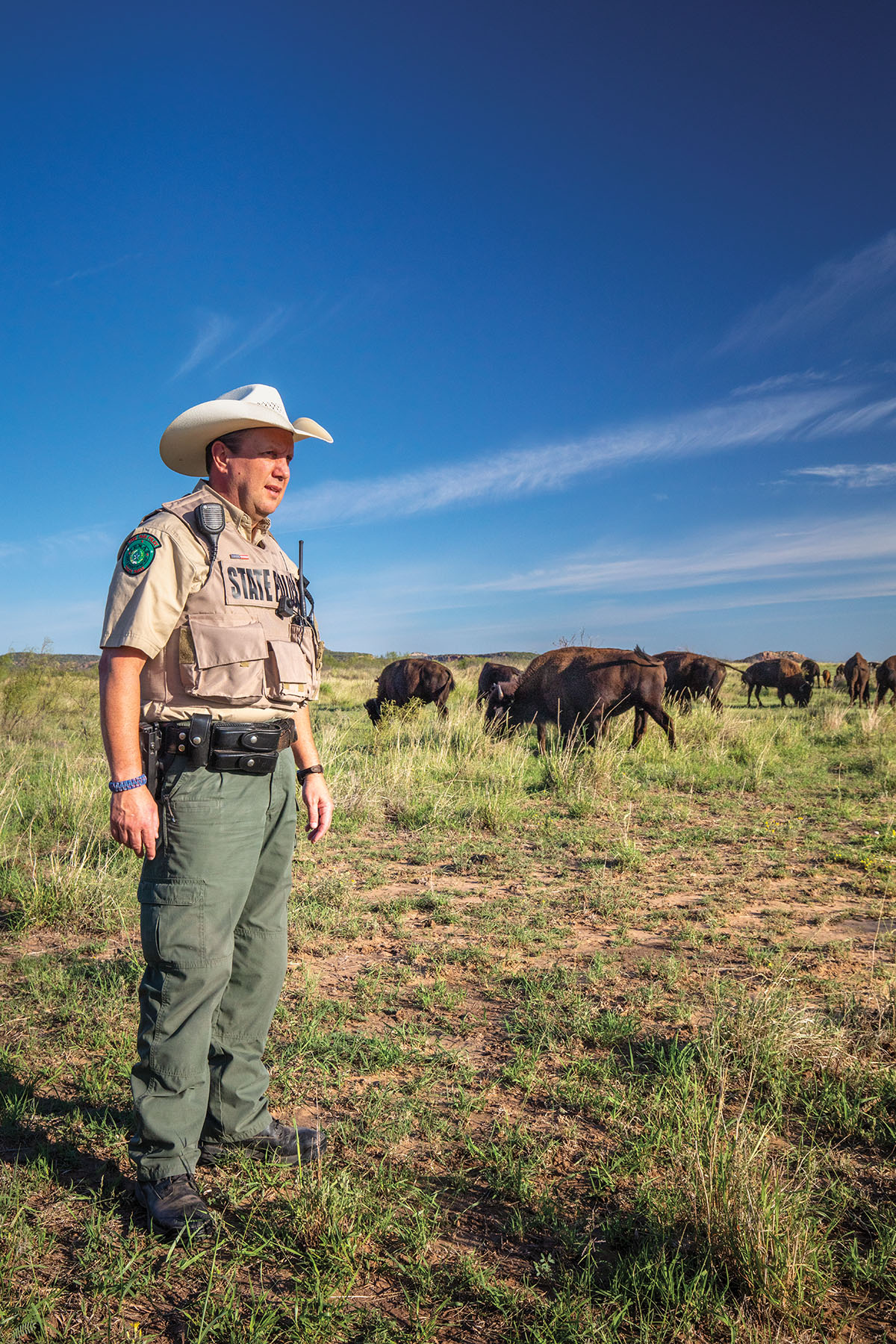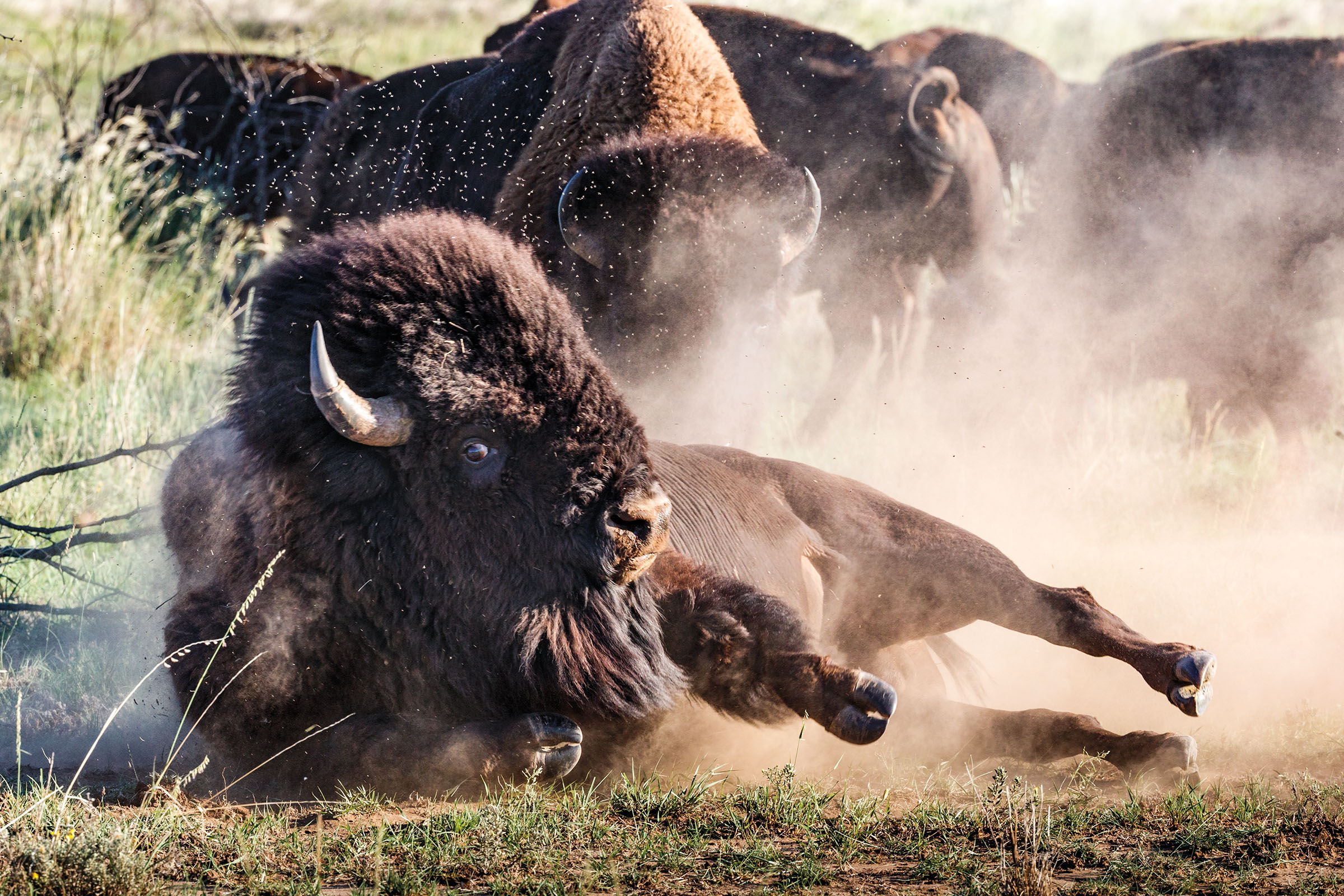
Donald Beard, Caprock Canyons State Park & Trailway superintendent, monitors the Texas State Bison Herd.
Charles Goodnight first encountered bison in late 1845. Moving from Illinois to Texas, his family stopped to camp in Dallas, which at the time consisted of one log cabin and a Trinity River ferry boat. The Goodnights traveled with two wagons, and 9-year-old Charles rode bareback on a mare. After crossing the river, the family continued south to the area now known as Oak Cliff. There, Goodnight watched as hunters used hounds to corner a group of about 10 bison—commonly known by the misnomer buffalo—and shot them for meat and hides.
Caprock Canyons State Park & Trailway
850 Caprock Canyon Park Road, Quitaque.
806-455-1492; tpwd.texas.gov
Goodnight saw similar scenes throughout his childhood in Milam County. When he rode out of the Cross Timbers region in 1876 and settled in Palo Duro Canyon to build a ranch, he came upon piles of skinned bison carcasses left behind by buffalo hunters. “I would hardly ever be out of the sound of guns from sun-up to sun-down,” he later wrote of those days in My Remembrance of and What I Know about Buffalo, now archived at the Haley Memorial Library & History Center in Midland.
As a teen, Goodnight worked as a farmhand and, with the help of his relatives, pieced together his own cattle herd. His ranching pursuits were disrupted by clashes with Native Americans and the Civil War, during which he served as a guide for the Texas Rangers and in a frontier regiment of the Confederate army. Goodnight returned to the cattle business in the mid-1860s. In the ensuing years, he would forge the Goodnight-Loving Trail on cattle drives from Texas to Wyoming with his business partner, Oliver Loving. He would also become a pioneering cattleman in the Texas Panhandle as the founder of the JA Ranch. By 1888, the Rand, McNally & Co. travel guide described Goodnight as a “baron” who owned every building in Armstrong and Donley counties.
But Goodnight’s most enduring legacy—as a rancher who crossbred cattle and bison—has taken longer to be fully recognized. He’s well known for his part in bringing bison back from the brink of extinction, largely at the urging of his wife, Mary Ann “Molly” Dyer Goodnight. In the past few years, scientists have begun to realize the impact of this crossbreeding: The experiments of Goodnight and other ranchers changed the genetic makeup of the American bison forever.
The Rolling Plains’ horizon dips and rises east of the town of Quitaque, pronounced “Kitty-Kway.” To the west, the High Plains of the Llano Estacado stretch flat to New Mexico. Between the two ecoregions, the landscape drops unexpectedly into Caprock Canyons State Park & Trailway, home to red bluffs that define the edge of the Caprock Escarpment as it gives way to the Rolling Plains. The 250 animals of the Texas State Bison Herd that roam the park’s transition zone are descendants of Goodnight’s bison herd.
The Texas State Bison Herd is one of Caprock Canyon’s biggest attractions. But that doesn’t mean the animals will be waiting around for photo opportunities. One day, bison might be milling in the front pasture. The next, a few might be drinking from a trough a mile away. The next, you could encounter a group in a red-rock arroyo.
“I’ve been here 13 years, and I still can’t figure out their pattern,” park superintendent Donald Beard says. “They’re a mystery to me.”

The bison of Palo Duro Canyon—about 50 miles northwest of Caprock Canyons—were easy for Goodnight to spot when he first arrived in November 1876 with 1,600 head of cattle. He estimated there were 10,000 bison in the canyon. His party shot rifles at the ground to drive them out so the cattle would have room to graze, he told historian J. Evetts Haley in a 1927 interview—one of many that resulted in Haley’s biography Charles Goodnight, Cowman and Plainsman.
“You never saw the like of the red dust they raised and it made a wonderful sight, such as you’ll never see again,” Goodnight said.
Buffalo hunting was at its peak in Texas in the 1870s. Some hunters killed as many as 100 in a couple of hours. While Plains Indians including the Comanche and Crow tribes relied on bison for sustenance, American hunters killed them for their hides, which were shipped east to make leather and clothing. Molly was “distressed by the slaughter” around them, Haley recounts, and in 1878, she convinced Goodnight to start his own herd. Goodnight roped bison calves, and Molly milked the cows to feed the babies. As he worked with the animals, Goodnight found them to be superior to cattle—more intelligent, hardier, and less water-reliant. As a breeder, he wanted to transfer those qualities to his cattle stock.
“He thought, ‘You know what? If I could breed bison and cattle together, maybe I could get a hybrid animal that’s got the toughness, hardiness, and disease resistance that bison do, but produces meat and fat like my beef cattle do,’” explains James Derr, a geneticist at Texas A&M University. “So, he tried it.”
Goodnight was successful. Newspapers across the country carried reports of Goodnight’s hybrid “cattalo” around the turn of the century. He wasn’t the only one crossbreeding. Charles “Buffalo” Jones, a rancher from Kansas, was conducting similar work and visited Goodnight’s ranch in 1901 to discuss their results.
Mixing the animals wasn’t as straightforward as it might seem. Numerous intricacies related to breed and gender jeopardized a successful birth. The Texas writer J. Frank Dobie detailed one such scenario in notes he took during a 1926 interview with Goodnight. “A cow bred to a buffalo bull stands just one chance in four of living and delivering her calf,” Dobie wrote in the unpublished manuscript, Charles Goodnight, Observer and Man. “If the embryonic calf is male, she will certainly die several months before it is due to be born. If it is female, she has a 50-50 chance.”
Distinguishing Traits
New research at Texas A&M University could change how ranchers and conservationists manage their bison herds.
In a study published in April 2022 in Scientific Reports, James Derr and Brian W. Davis, geneticists at Texas A&M, concluded that all the bison in North America have a legacy of hybridization.
Derr’s previous research dating back two decades had found that some, but not all, bison share DNA with domestic cattle. The idea that herds of “pure” bison still existed at places such as Yellowstone National Park led wildlife officials to manage those herds separate from others.
With genome sequencing becoming more affordable in recent years, Derr, Davis, and graduate student Sam Stroupe revisited the subject of bison DNA. The technology they worked with was many times more magnified than when Derr conducted his original research. By writing computer programs to compare the genomes of bison with cattle from across the continent, they found that all North American bison carry cattle DNA.
“With this paper, I have to change my tune,” Derr says. “In the long term, this is good for conservation. From a genetic standpoint, there’s no reason to keep certain herds isolated from others. It opens up opportunities for bison conservation.”
Though Goodnight found success, the hybrid animal turned out to be less valuable than cattle in the meat markets. “They had a big head and hump and a small rump,” Derr says. “You don’t make a lot of money selling a beef animal from its head. For the most part, the expensive cuts of meat are in the back.”
At the turn of the 20th century, Goodnight and others gave up breeding cattalo, but the experiment had gone on long enough to change the entire bison species. “Even though they stopped doing it, we’re still left with the legacy of that in bison genomes,” Derr says.
At the most precarious point in the late 1800s, the bison population of North America had dropped to as low as 300 animals. Now, biologists say there are more than 400,000 animals living on private ranches, in parks, and in conservation herds like the State Bison Herd. This spring, the herd at Caprock Canyons is expecting about 80 new calves. As a result of breeding efforts by Goodnight and others, all of them still carry small amounts of legacy cattle DNA.
“We’ve got really the last remaining Southern Plains bison herd in existence,” Derr says. “From a conservation standpoint, it’s an extremely valuable bison herd.”








